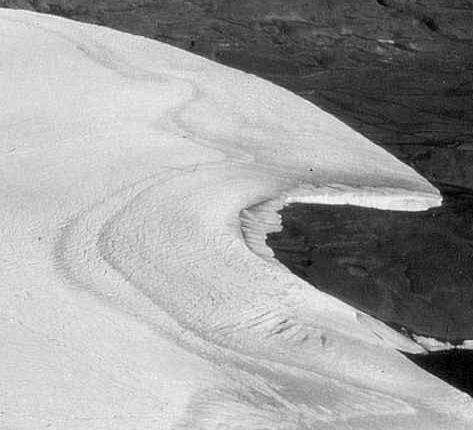1. On the Greenland Ice Sheet
Ice sheets form as a consequence of the progressive deposition of snow on a landmass. As snow falls and metamorphoses into ice [1], particles follow pathways towards the ice margin, such as shown in Fig 1 [2]. As a result, in the summer the older ice layers are exposed in the ablation zone (that is, the marginal region where the previous year’s snowfall has sublimated or melted entirely).

Figure 1 Ice particle flow paths inside an ice sheet. Image reproduced from [2].
Along the margin of the Greenland Ice Sheet (GrIS), surface melting exposes a visible stratigraphy with variable dust content. An example of this is shown in Fig 2 [3], pictured at Kronprins Christian Land (North-East of GrIS).

Figure 2 Exposed stratigraphy (ice/dust) on the margins of GrIS at Kronprins Christian Land. Photography reproduced from [3].
By conducting δ18O measurements on the exposed ice, [3] and [4] have identified the low-dust (clearer) ice to the left in Fig. 2 as being Holocene and the high-dust (dirty) ice close to the margin as pre-Holocene ice.
Another way to study the dust layers on the GrIS is to drill ice cores [5]. This technique allows us to characterise the size and shape of dust trapped within the ice and to match it with the contemporary climate [5, 6].
2. The Problem
Layered deposits of ice and dust cover the Martian poles. These Polar Layered Deposits (PLD) have been mapped from orbiters, revealing a stratigraphy thought to be linked with changes in the orbital parameters of Mars [e.g. 7]. PLD are in some places exposed, which allows us to study their reflectance [8, 9].
Reflectance models, such as the widely-used model developed by Hapke [10], are tools that allow us to retrieve the amount of dust present within a surface from its reflectance spectrum. It has been shown that this model only reproduces the reflectance of an ice and dust mixture accurately if the size and shape of the dust grains are well known [11]. Without knowledge of those two parameters, the errors made in the modelling of the reflectance of dust and ice mixtures are expected to be decisive.
3. Our Approach
We propose to use our knowledge of the characteristics of the dust in the Greenland ice sheet to calibrate Hapke’s reflectance model as follows:
This exercise will allow us to assess the performance of the reflectance model when it comes to fit reflectance spectra obtained from satellite imagery. By doing so, we aim to evaluate how accurately we can derive dust concentrations from the Martian PLD using similar approaches.
Acknowledgements
This work has been carried out within the framework of an Early.Postdoc Mobility granted by the Swiss National Science Foundation.
References
[1] T. Blunier and J. Schwander (2000). Physics of Ice Core Records: 307-326
[2] Rapp D. (2013) Ice Ages and Interglacials. Springer Praxis Books.
[3] Reeh et al (2002). Annals of Glaciology, 35.
[4] MacGregor et al (2019). AGU, Abstract #C11C-1280.
[5] Vallelonga P. T. and Svensson A. (2014) Springer Science, 463-485.
[6] Scheuvens D. and Kandler K. (2014) Springer Science, 15-50
[7] Smith I. B. et al. (2016) Icarus, 308, 2-14.
[8] Becerra P. et al. (2017) GRL, 44, 66-70.
[9] Becerra P. et al. (2019) GRL, 46, 7268-7277
[10] Hapke (1993). Cambridge University Press.
[11] Yoldi Z. et al. (2015) GRL, 42, 6205-6212
[12] Svensson A. et al. (2005) JGR, 110


